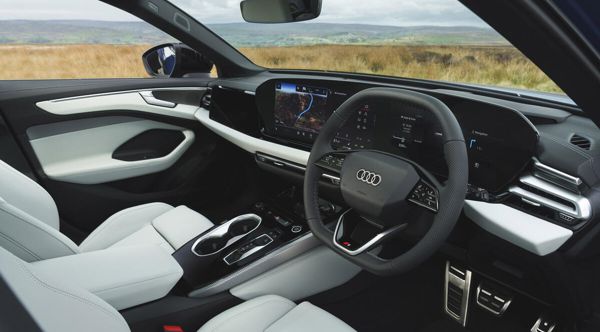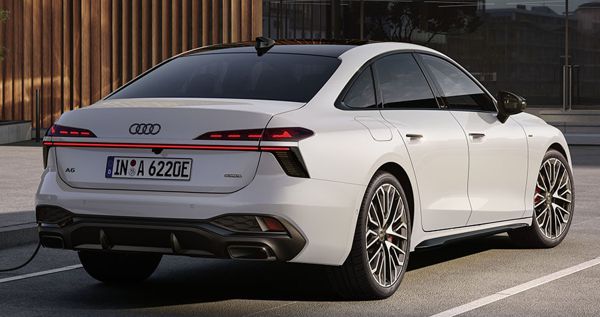Same
name, different cars. That’s how confusing the new Audi A6 is. On the
one hand you get an all-electric
A6 etron
which is built on a brand-new skateboard platform called PPE (Premium
Platform Electric). On the other hand, Audi does not want to lose
existing customers who are not going to switch to electric power any
time soon, so it develops the combustion power A6 into the 9th
generation and sells it alongside the electric alternative. To
distinguish the two, Ingolstadt planned to rename the combustion car to
A7, just to find out it caused confusion to the market and strongly
opposed
by its dealers. Eventually the A6 nameplate is kept, and you rely on
subtitles like TFSI, TDI or etron to distinguish the two very different
cars.
Predictably, investment to this combustion model has to be scaled back
a little in the view of expected reduction of sales volume, therefore
the new generation reuses the outgoing MLB Evo platform, just has it
renamed to PPC (Premium Platform Combustion) to sound fresh.
That said, there are still plenty of improvements can be made, one of
them is styling. While the outgoing A6 was the ugliest of all
generations, the new one is back on form. It might not match the
elegance of
Mk5 or
Mk6 in terms of small details, but it
looks unquestionably stylish, thanks to a sportier profile and
pronounced fenders. The front grille and intakes are too busy and out
of proportion in my eyes, but certainly not as intrusive as the
hard-edged grille and intakes on the outgoing model. Between the sedan
and Avant wagon, I would say the latter is more distinctive, because
the tailgate is set at an unusually fast angle and the wagon tail makes
the rear fenders look even more aggressive, which set it apart from its
BMW and Mercedes counterparts. The fast tailgate also lends the Avant a
remarkable drag coefficient of 0.25, while the sedan is 0.23.
At 5 meters long, the new
A6 is 60mm longer than the old car, but it is marginally narrower and
lower, while wheelbase is unchanged at 2923mm. It is worth noting
that while the A6 is unquestionably a large car, it is not a lot larger
than the A5 with which it shares the PPC platform – just 170mm longer,
15mm wider and 31mm longer in wheelbase.
The chassis continues to be made of primarily steel and some aluminum
structural parts. The outgoing car employed aluminum bonnet, boot lid,
doors and front fenders, and the new car has no reason not to follow.
That said, weight increase is inevitable these days due to addition of
hybridization and driver assistance technology, making every model at
least 200kg up on its equivalent predecessor.
The cabin of A6 is never short of room. Six-footers can sit comfortably
at back with knee room to spare, and unlike its etron sister you don’t
need to raise your legs as the footwell is deep. On the downside, the
transmission tunnel is quite prominent, making the third rear passenger
uncomfortable to travel long distances. Up front, you might be amazed
by the screen-heavy design – an 11.9-inch instrument, a 14.5-inch
touchscreen and an optional passenger-side touchscreen dominate the
dashboard and console. There are very few physical switches left.
Climate control can be accessed only by the touchscreen or voice
control. Fortunately, the user interface is quite well thought out,
with most frequently used functions presented permanently on main
screen and buttons are large for easy access. The Google-based
infotainment system is responsive and logical. Not so good is the
haptic touchpad on the steering wheel.
However, this cabin is still a disappointment. Not only it shares most
hardware with the cheaper A5, but it lacks the quality feel that Audi’s
interior has been famous for over the past couple of decades. The large
screens might look fancy, but they might just happen on any Chinese or
Korean or American cars, having little character or sense of occasion
to speak of. While the A6 sports classier materials than the A5, such
as real aluminum and soft plastics, you can still locate some materials
inadequate to this price point, let alone to the reputation of Audi,
such as the large piece of gloss black plastic covering transmission
tunnel, some brittle plastics at the door panels and scratchy plastics
around the air vents. The sense of build quality slips below BMW
5-Series and Mercedes E-class.

|
|
Screen
and tech-heavy cabin is let down by some cheap materials. |
|
The boot suffers, too. For a wagon, the Avant's luggage space is very
small at 503 liters. Worse still, it drops to 466 liters when equipped
with mild hybrid system, blame to the LFP battery stored under the boot
floor. PHEV models are smaller still, measuring just 354 liters in
sedan or 404 liters in Avant.
As in A5, both front and rear suspensions are 5-link setup, but the A6
can be optioned with adaptive air springs with adjustable ride height
and variable damping. Standard suspension rides on steel springs, while
S line uses stiffer and 20mm lower setup. 4-wheel drive system has
switched to Quattro Ultra, which uses a multiplate clutch to engage the
rear axle only when needed. Active rear-wheel steering is optional,
just like the last generation.
Engine lineup is simple, as there are only 3 choices and all of them
are identical to the A5. Entry-level is the 2.0 TFSI petrol, employing
Miller-cycle combustion and a VTG turbo to produce 204 hp. It used to
be a very good engine in many Volkswagen group cars, but hauling the
heavier A6 calls for revving the engine uncomfortably hard, losing the
aural refinement and effortless manner you would expect on such a
luxury car.
Comparatively, the 2.0 TDI is better, thanks to its stronger mid-range
torque and the fact that it is assisted with mild-hybrid technology,
which is strangely not available to the weaker 2.0 TFSI. Apart from
some
diesel clatter at very low revs, it feels hushed. The 48V
motor-generator attached outside the 7-speed dual-clutch transmission
can
provide up to 24 hp or regenerate up to 34 hp from braking. It fills
the torque gap between gearshifts and enhance smoothness. When mated
with Quattro – again not available to the 2.0 TFSI – the 2.0 TDI does
0-60 mph in a respectable 6.6 seconds.
The top engine is 3.0 TFSI, the same V6 used in S5 but not qualified
for S badge here. It uses also Miller-cycle and a VTG turbo to produce
367 hp, accompanied with 406 lbft of torque. Quattro is standard, as is
the mild-hybrid system. It is good for 0-60 mph in 4.5 seconds.

|
|
Rides
well with or without air suspension; Steering is surprisingly good.
|
|
Besides, there are 2 plug-in hybrid models mating the 2.0 TFSI engine
with a transmission-incorporated electric motor and 25.9 kWh lithium
battery. They produce 299 hp or 367 hp combined output, but weight
penalty means they are no threat to the V6 model. Their main benefit is
100km of electric range, which qualifies for reduced taxes in many
countries.
If money is not a consideration, the V6 is the best option, of course,
because only this motor provides the kind of smoothness, refinement and
effortless manner a luxury car deserves. Somehow, the world has changed
under the threat of global warming. Big multi-cylinder engines become
casualties, leaving most buyers choosing between four-cylinders (or
even triple) and electric drive.
In cruising, the A6 is very refined, as its cabin is well insulated
from wind and road noise. Audi talks of using more sound deadening
materials, better window and door seals, improved powertrain mounting
bushings as well as noise-absorbing tires.
The suspension also does the job well, no matter on standard steel
springs or optional air springs, returning a generally smooth ride on
wheels up to 20-inch. However, the air suspension does have the benefit
on handling, tightening body movements in corners and on undulating
roads, so it is highly recommended. Likewise, the optional rear-wheel
steering helps boosting agility in town, allowing the big A6 to
maneuver in tight spaces more like a compact car.
The A6 is generally good to drive. Its steering is surprisingly good
for an Audi, being accurate, reassuringly well weighted and even has
some feel. The car balances quite well, too, showing little of the
understeering character of the old Audi. It also provides good grip and
traction, especially with Quattro. A sports sedan it is not, but it
paves the way for a better S6 and RS6 to come.